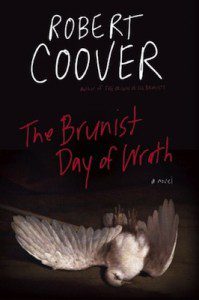
Forty-seven years ago this month, a NY Times review of The Origin of the Brunists opened with “Robert Coover writes his first novel as if he doesn’t expect to make it to a second.”
In that novel, a mine disaster kills 98 men, leaving only one survivor: a simple man named Giovanni Bruno, an Italian Catholic in a divided town, who emerges from the mine changed, speaking in prophetic (or deranged) apothegms. He heralds, to some, the fulfillment of their respective religious ideations. The town of West Condon, from disaster and religious fanaticism and factioning alike, comes apart, culminating in a violent confrontation at the hour The Brunists expect to be raptured. It is a grand tragicomic social novel, filled with characters, stories, sex, violence, religion, politics, and much more.
And, now, Coover has written a second.
Of course, after that review, Coover has written many novels and collections, and I would argue has shown himself to be, as that reviewer suggested (“if he [could] somehow control his Hollywood giganticism”), “heir to Dreiser or Lewis.” And maybe Twain, too. But this second Brunist novel, The Brunist Day of Wrath, with all its brilliant giganticism still here, controlled or raucously sprawling, has the same everything-in, the same wit and vigor and sense of the writer’s sheer joy, as its predecessor.
This (almost fifty years later!) is incredible and exciting enough, really, to recommend the book. But that fact alone is nothing in the light (a significant word) of the sequel he’s delivered.
Where we pick the story up is not fifty but five years after the mine disaster. The Brunists return to West Condon once again expecting the end of all things. Five years later, the town is deeply depressed, suffering from the economic losses following the mine closure, the personal losses of the men who died in the mines, and the painful fracturing of the town brought on by the Brunists. Quickly things come to conflict again, and repeatedly, though this time each encounter begets only further and far worse violence, until finally the Brunists celebrate a sort of anniversary—the portentous seventh day of the seventh month, the wrathful day the book opens on and builds back to, determined to be the date of the End after much self-serving reading of prophetic signs, including listening to the ghostly sounds that haunt the silences between speech—with all sides suffering far greater destruction than five years ago. The narrative of this one day, itself spanning over 140 pages, is soul-shuddering and panoramic and cinematic and harrowing and good.
To attempt a more complete summary of this nearly 1,200-page epic from there defies my 1,200-word space.
The book—despite its length and complexity—is fast-paced, exciting, and one of the most action-filled novels I’ve read recently: the toppling of the town’s government, suspicions of Mafia influence, a second Second Coming, fomentations of race war and religious war, violence of all kinds, from barroom brawls and brass knuckles to gun battles, aerial attacks, drive-bys, bombings—an unholy holy war is unleashed on West Condon, as another End of the World seems imminent to the Brunists.

Along with all the eschatology and action, the book manages to balance careful psychological explorations of almost every character. Whether they are the fool or the faithful, the villain or the virgin, Coover humanizes his characters, presents them as they think and perceive, without his judgments swaying them or betraying how he feels about them. Even the most violent and maniacal, the most self-involved or deluded, are presented from their side, where what they’re doing fits their narrative.
By viewing everything that happens through many differing perspectives, Coover explores and illustrates the self-oriented nature of every character—religious or otherwise—which often includes not only the way all evidence serves their particular thesis, but also their inability (or lack of will) to see things from another’s perspective. Whether it’s Ted Cavanaugh, the town banker and putative civic leader, or Abner Baxter, the fiery one-time Communist labor-leader turned baptism-by-fire Brunist bishop; the hapless sucker Georgie Lucci or the terrorist leader Nat Baxter; the minister with his in-dwelling Christ or the women reading palms and interpreting dreams at the Brunist camp: everyone sees their own interests as uppermost, failing to see themselves as they are seen by others.
Not to make it sound like this is a moralistic novel that explores this self-orientedness in order to critique religion or politics or labor relations or whatever: it is not tendentious. Reading Robert Coover is great fun. He can be bawdy and lewd; he has folksy singers and badly-behaved children; drunks, gamblers, cheaters, crooks, bums, loose ladies, and two confused old men, who get lost taking turns searching for the other and forgetting what they’re doing. There are plenty of hangovers, hook-ups, pornographic photos, prophesying, fights, kidnappings, confrontations, and more than one resurrection.
But though these characters tend to see things only from their own circumscribed perspectives, within their own narratives, we, the readers, actually see things from many different perspectives. We see how each character justifies the good and the bad he or she does. We see how each person—fully sketched out, speaking and thinking in his or her own vernacular—believes his or her own truths and lies.
Coover notes of his writer character, Sally Elliot (who is credited with the book’s epigraph), near the end of the novel, “By now, Sally was losing sympathy with her crazed hero and his nutty apocalyptic imaginings and she had to work hard to make the genuineness of his emotions believable.” I imagine this was true of Coover himself in many cases, as his various crazed characters with their nutty apocalyptic imaginings are not always easy to sympathize with. But, nonetheless, Coover manages to do this hard work and to make their emotions believable, their viewpoints compelling, and their psychologies both nutty and real.
This might be the point, here, despite the fun and the action and the comedy and the tragedy: as Sally sees her own work, it is not against individuals; “…the real criminal that day was Christianity itself. Or, rather, the human mindset—in part, a susceptibility to made-up stories—that gives this dangerous nonsense such terrible power.”
The power of these made-up stories, though sometimes dangerous or terrible, can also be redemptive and freeing (and just plain entertaining). Like its predecessor, the novel is packed with stories, and I think it is significant that Coover ends the novel with two long sections from the POVs of storytellers. First, a woman steeped in bible stories whose sartorial role models are biblical women, who crafts an elaborate and factitious version of the events that have happened (in which they will continue happening, revised and renewed and repeated, indefinitely) for the benefit of a listener who cannot challenge her version (though clearly doubts its accuracy). She risks, in this fictive and revisionist history-telling, losing herself and her sanity as reality slips under the surface of her creation. Her religious background is important, in this regard, as it relates to the returned-Jesus-slash-nutty-minister’s claims that all the history written about him—the gospels, the Pauline epistles, much of the New Testament—are badly-told stories, fictions that mistake what he really meant and said and intended.
But not all stories are so harmful or willfully unconcerned with truth. The other long storyteller section centers on Sally, who writes her own novel of the Brunist day of wrath and through so doing shows that stories can be compassionate, can be fair even to the least worthy, can serve social justice, seeking truth even in fiction, even against what our beliefs and our emotions would lead us to want.
Thus Coover’s second epic telling of the many stories of the Brunists and West Condon shows that stories can be, all at once, nutty apocalyptic imaginings, sprawling gigantic entertainments, terribly powerful lies, and redemptive and compassionate bridges between disparate selves. And, really, wicked fun.




